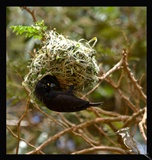PHOWN summaries and recordsVirtual Museum View records in Virtual Museum formatCoverage map for all species Species totals, Nest stats per species and Observer totals Species summary , or General query Observer records, or View VM record Photo of the week, or PHOWN repeats, or PHOWN priorities |
PHOWN record summary
|
Enter new vm record to see a different record and hit 'Go'.
|
Species allocated by Coordinator: Record details entered by participant: (see all records here for this participant) Google map for this record (zoom in and switch to satellite view)
Photos uploaded by observer



Large photos
808, Southern Red Bishop Euplectes orix (see species summary here)Record status ACCEPTED Vm 5065 [on-line data upload (2013-01-22): 31237] Species Southern Red Bishop Observer(s) Zaloumis, Alex Country, town, locus South Africa, Gauteng, Johannesburg,
2528CCLocality cnr Champion & Bridal Pass, Beaulieu, Midrand Latitude, longitude -25.935561111111, 28.059744444444 [0 m accuracy] Date 2013/1/8 Notes location. Large reedbeds off the road at top of shallow dam. Many other red bishops and masked weavers nesting all over this area and the suburb in general. This location is off Champion, off Bridal Pass Rd. Nests - pics of 2 diff nests taken. - obviously many more. Nest count 0 Nest site reed
To see this map with all other PHOWN records, click here. Note that the map on this page will load very slowly and probably will only work if you use Chrome as a browser.
History of repeat colony counts
Note: repeats from the same day are not shown.vm Species code Date Nests Notes 5064 803 8/1/2013 9 Location - alongside road in dense reed beds at top of dam - off Champion Rd. off bridal Pass rd.
No access but many Sthn Masked weavers nesting in dense reed beds of shallow dam. Pic taken of a concentration of about 9 nests. Reeds alongside nests stripped. Females and males busy, probably feeding chicks. Nest count - 9 plus many more.
Note: this residential peri urban area has many 5 hct. plots, most with pools and dams. Observing from the road there were small masked weaver colonies & nests in most plots. Some in reedbeds, willow trees, fever & other thorn trees, even rhus - Obvious that area was once grassland but now becoming a treed suburb and the masked weaver is thriving & expanding range as there is lots of water, suitable trees - as well as dog, horse, cattle and chicken food etc. 
Vm 5064










